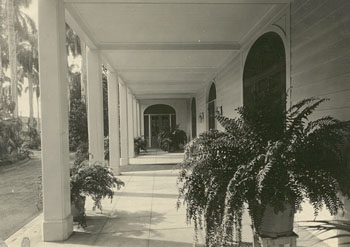“In the block on King street, bordered by Alapai and facing makai, there stands a garden. It is an old garden because the royal palms tower so high, and only ancient palms attain so majestic a height.”
“For many years the owner of this garden, Mrs. Juliette M. Atherton, planted and tended the shrubs, vines and ferns with loving care. She named her home embowered in the shade of growing things, Fernhurst.” (The Friend, November 1921)
Let’s step back a bit and get some context.
William Richard Castle and Amos Starr Cooke founded the Castle and Cooke Company in 1851. Joseph Ballard Atherton began his career as a clerk with Castle and Cooke after coming to Hawaiʻi in 1858.
He married Amos’ daughter Juliette Montague Cooke and rose to the presidency of the company, one of the “Big Five” firms that had a major influence on the economy of Hawaiʻi.
The Atherton’s home was ‘Fernhurst,’ described above.
In 1921, the Atherton family gifted their near-downtown residence, Fernhurst, to the YWCA in memory of their daughter, Kate, and in tribute to her deep interest in the welfare of girls.
The YWCA of Oʻahu is the oldest continuous service organization devoted to women and children in Hawaiʻi; in 1900, a small group of women met at Mrs. BF Dillingham’s home at Arcadia on Punahou Street to organize the YWCA.
From the beginning, the YWCA was organized to provide the working women of Honolulu a safe place to build friendships, develop or maintain solid values and learn skills to become more productive members of the community; but over the years, the vehicles for accomplishing those goals have changed in response to the times.
Earliest classes included English, Bible and lace-making. By 1906, when it joined the YWCA of the USA, recreational and athletic programs including tennis and swimming classes had been added.
The first YWCA residence for young working women, The Homestead, was opened and addressed community concerns over the lack of safe and affordable housing accommodations in Hawaii.
Then, in 1921, Fernhurst was added to the YWCA. The original Fernhurst served as a temporary home for as many as 10,000 young working women.
In the 1940s, when housing was at a premium due to the arrival of civilian war workers, Fernhurst was one of the most active gathering places in the city.
‘The Friend’ recorded the house blessing: “Another generation will pass in and out the noble driveway and occupy the inviting rooms and broad lanais of the commodious white building, risen on the site of the family home of the Athertons, as if it grew there like the protecting trees that shield it from the glare of our Island sunlight.”
“Perceiving the need of a new YWCA home for girls who come from their own far-off homes, the Atherton family have built this sheltering roof tree, and have presented it to the Association, a fitting memorial to their sister, Kate Marion Atherton.”
“It bears the same name as the former Fernhurst, home of Mr. and Mrs. J. B. Atherton, that Christian home of cheer and friendliness, where the latch-string was always out for friend and stranger alike.” (The Friend, November 1921)
Three years later, in 1924, Julia Morgan was retained to design a new main YWCA facility on Richards Street and “Laniākea,” as it was aptly named, was dedicated in 1927.
Later, in 1952, the Fernhurst property was sold to the Honolulu Rapid Transit Authority (the site is now the bus transit depot at Alapai and King Streets) and another ‘Fernhurst’ opened at its present location on Wilder Avenue, near Punahou School in Makiki.
Today, the facility is entirely mission oriented and dedicated to empowering women successfully transitioning from prison back into the community.
Homebase is offered as an extended affordable housing option for women who complete the Ka Hale Ho‘āla Hou No Nā Wāhine furlough program. (YWCA)
Follow Peter T Young on Facebook
Follow Peter T Young on Google+
Follow Peter T Young on LinkedIn
Follow Peter T Young on Blogger


































